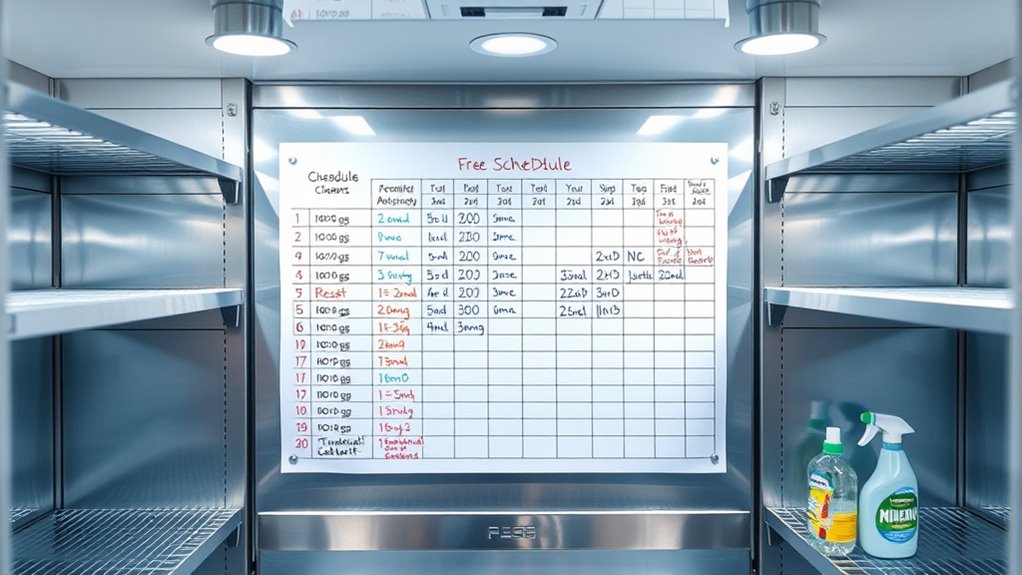A batch-freezer cleaning schedule helps you keep equipment sanitary, prevent contamination, and guarantee safety. Start by planning your routine, choosing the right tools, and training your team on proper techniques. Assign responsibilities and document each step for accountability. Regular inspections catch issues early and keep the freezer running efficiently. Staying consistent and following safety protocols protect product quality. Keep exploring to discover detailed steps and tips for an effective cleaning plan.
Key Takeaways
- Develop a tailored cleaning schedule based on freezer usage frequency, including daily and weekly tasks.
- Train staff regularly on proper cleaning techniques, safety, and documentation practices.
- Ensure all cleaning tools and equipment are available, maintained, and suitable for hard-to-reach areas.
- Incorporate routine inspections to verify cleanliness, identify issues, and adjust schedules accordingly.
- Maintain detailed records of cleaning activities to ensure accountability, safety, and continuous improvement.

Have you established a clear cleaning schedule for your batch freezer? If not, you’re risking contamination, equipment failure, and inconsistent product quality. A well-structured cleaning routine guarantees your freezer stays in peak condition, extends its lifespan, and maintains food safety standards. Start by identifying all cleaning equipment you’ll need—scrapers, brushes, sanitizers, and microfiber cloths. Having the right tools on hand makes the process more efficient and thorough. When creating your schedule, consider the manufacturer’s recommendations, but also tailor it based on your production volume and usage frequency. High-turnover freezers may need daily cleaning, while others can be scheduled weekly. Document each step clearly so staff knows exactly what to do and when. Proper staff training is essential here; everyone involved must understand the importance of consistent cleaning practices. Proper training ensures staff know how to operate cleaning equipment safely and effectively, minimizing the risk of damage or contamination. Conduct regular training sessions and refreshers, emphasizing proper sanitization techniques and the correct use of cleaning tools. This helps prevent shortcuts or improper procedures that could compromise the equipment or product safety. Establishing a routine also involves assigning specific responsibilities to team members, making sure each person understands their role in the cleaning process. Use visual guides or checklists to reinforce these responsibilities and ensure nothing is overlooked. Consistency is key, so encourage staff to follow the schedule precisely and document completed tasks for accountability. Incorporate routine inspections into your schedule to verify that cleaning procedures are being followed correctly and equipment is in good condition. Regular inspections help identify issues early, such as worn seals or buildup, which can be addressed before they cause bigger problems. Remember, cleaning isn’t just about appearance; it’s about removing residues, bacteria, and potential allergens. This means paying special attention to hard-to-reach areas and ensuring sanitizers are used correctly. Reinforcing staff training on the importance of these details ensures your team remains vigilant. Additionally, review and adjust your cleaning schedule periodically based on operational changes, new equipment, or evolving safety standards. Staying proactive in maintaining your batch freezer prevents costly breakdowns and helps uphold your product quality. Incorporating knowledge about effective cleaning techniques can further improve your routine and ensure thorough sanitation. Ultimately, a clear, well-trained team following a meticulous cleaning schedule minimizes downtime, maximizes efficiency, and guarantees the safety of your end product. By investing time in staff training and maintaining a consistent cleaning routine with the right equipment, you safeguard your operation from potential hazards and keep your freezer running smoothly.
Frequently Asked Questions
How Often Should the Batch-Freezer Be Deep Cleaned?
You should deep clean your batch-freezer based on its storage temperature and cleaning frequency recommendations. Typically, a thorough cleaning is needed every three to six months, especially if the freezer is used frequently or stored at higher temperatures. Regular cleaning helps prevent bacteria buildup and guarantees proper temperature regulation. By maintaining a consistent schedule, you keep your freezer in ideal condition and ensure food safety and quality.
What Cleaning Products Are Safest for the Freezer?
Think of your freezer as a treasure chest—keeping it clean preserves its value. You should use food-safe disinfectants and eco-friendly cleaners to guarantee safety and sustainability. I once used a vinegar-based cleaner, and it worked wonders without harsh chemicals. Always check labels to confirm products are safe for food contact surfaces. These options protect your freezer and the environment, making cleaning both effective and responsible.
How to Handle Frozen Product Spills During Cleaning?
When handling frozen product spills, you should focus on spill management and cleanup procedures. First, put on protective gloves to prevent contamination. Use a scoop or spatula to carefully remove the frozen product, avoiding cross-contamination. Then, clean the area with a suitable disinfectant, following proper sanitation guidelines. Confirm the area is thoroughly dry before closing the freezer, and document the spill for maintenance records.
Are There Any Specific Safety Precautions to Follow?
When cleaning the freezer, you should prioritize safety by wearing personal protective equipment, following chemical safety guidelines, and staying alert to potential hazards. Always wear gloves, goggles, and aprons to protect your skin and eyes. Read labels carefully, handle chemicals responsibly, and guarantee proper ventilation. By adhering to these precautions, you minimize risks, safeguard your health, and maintain a safe, efficient cleaning process.
Can Cleaning Be Scheduled During Normal Operating Hours?
You can schedule cleaning during operating hours if your cleaning schedule aligns with your production needs. It’s important to plan carefully so cleaning doesn’t disrupt normal operating hours. Communicate with your team to ensure safety and efficiency. Adjust your cleaning schedule as needed to maintain hygiene standards without interfering with daily operations. Proper planning helps you keep the freezer clean while maintaining smooth, uninterrupted production.
Conclusion
Keep your batch freezer in tip-top shape by sticking to this cleaning schedule. Regular maintenance helps prevent minor hiccups from turning into bigger issues, ensuring everything runs smoothly and efficiently. Think of it as giving your equipment a gentle refresh, a little pampering that pays off in the long run. By staying consistent, you’ll keep the process seamless and your results consistently excellent. Remember, a well-cared-for freezer is the secret to hassle-free operation.









